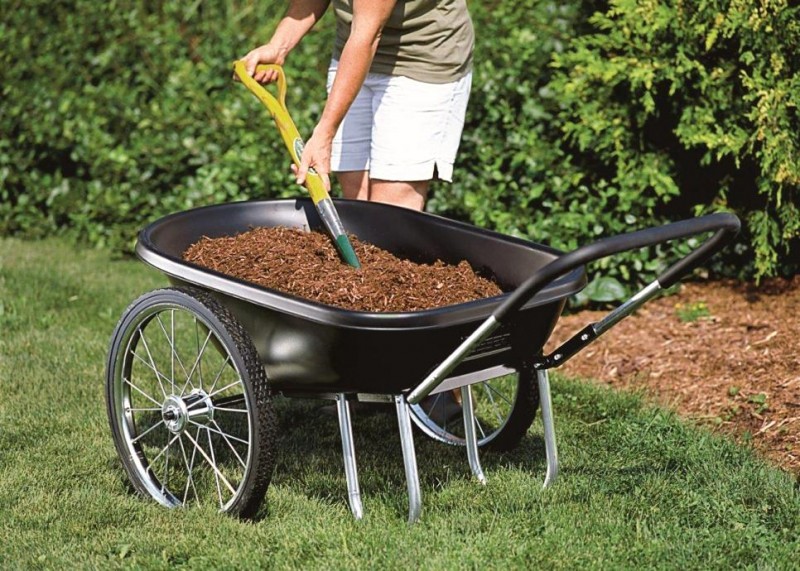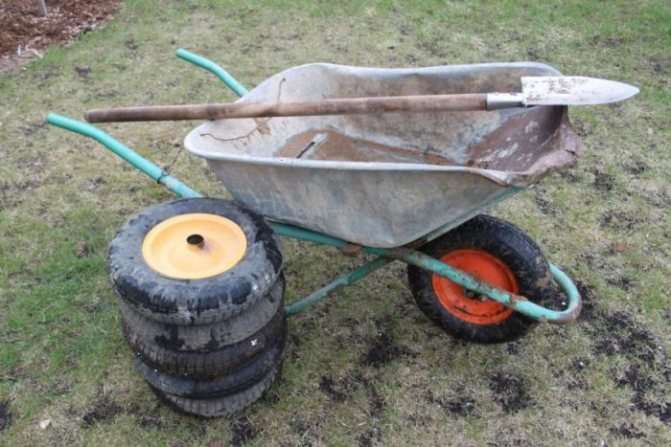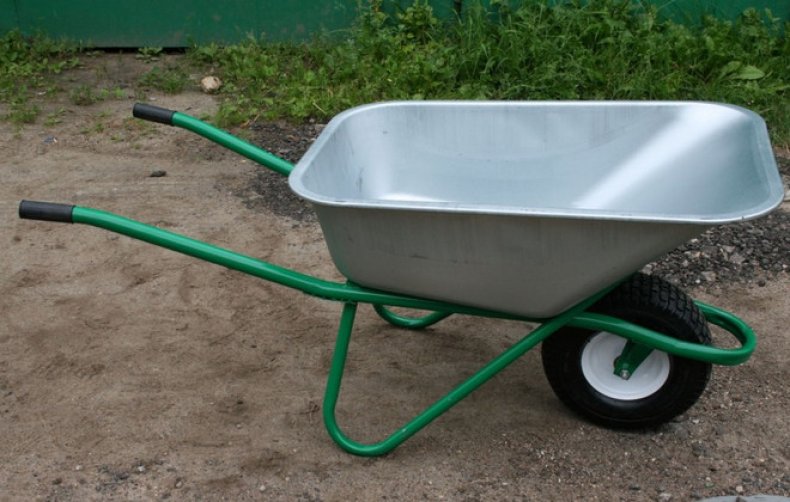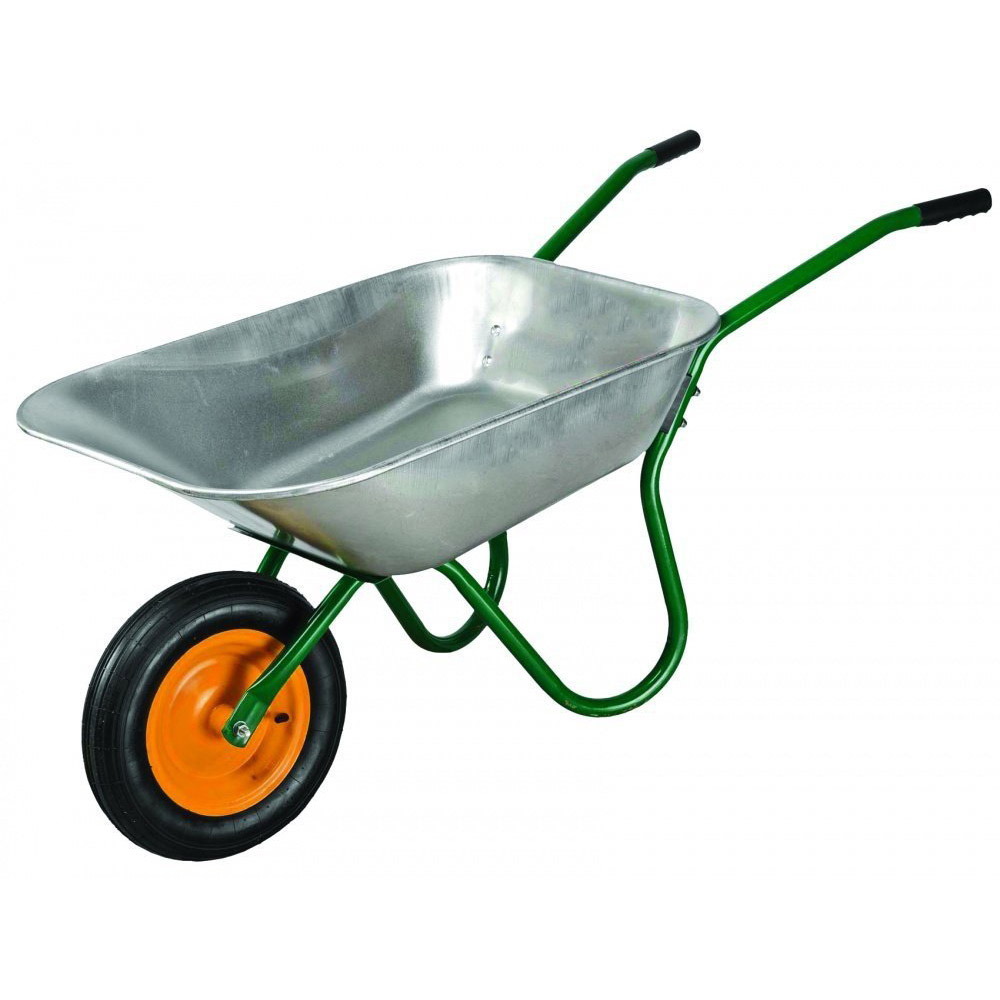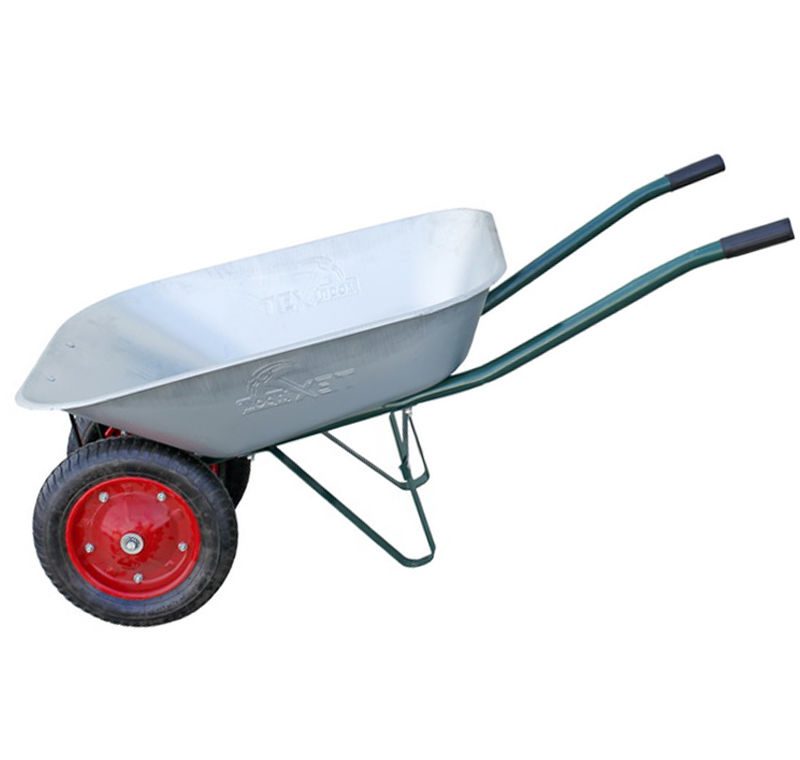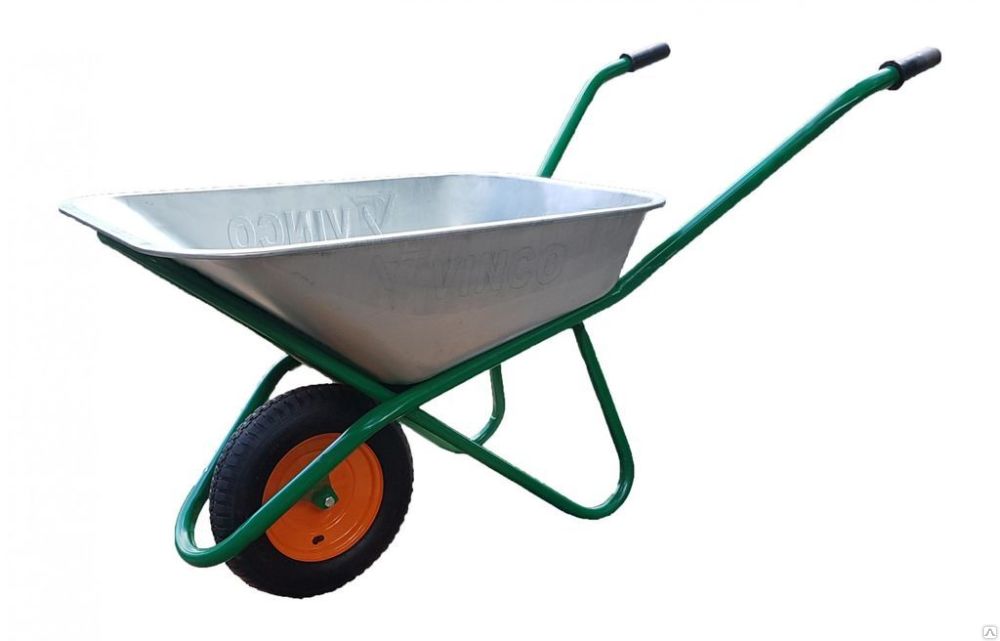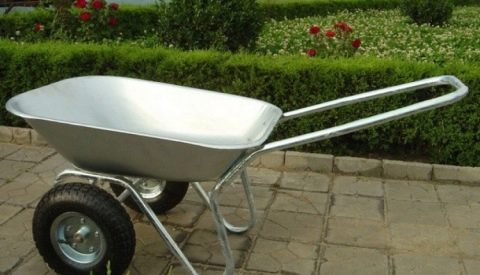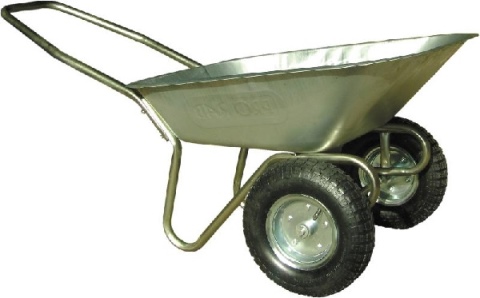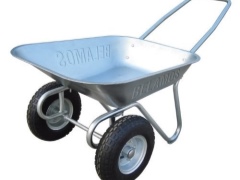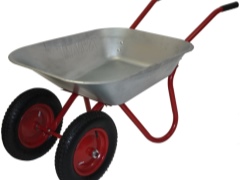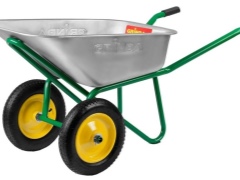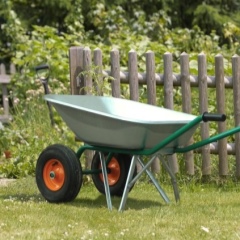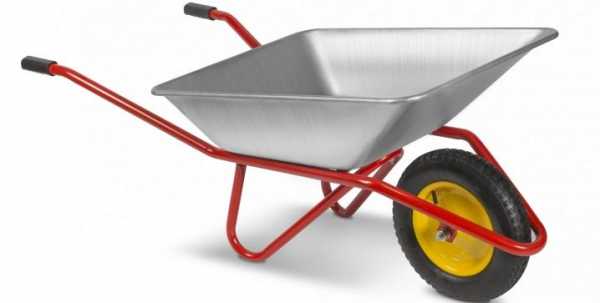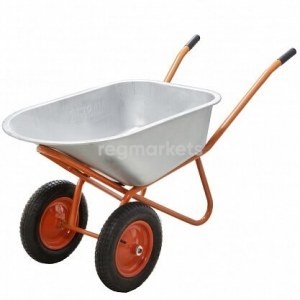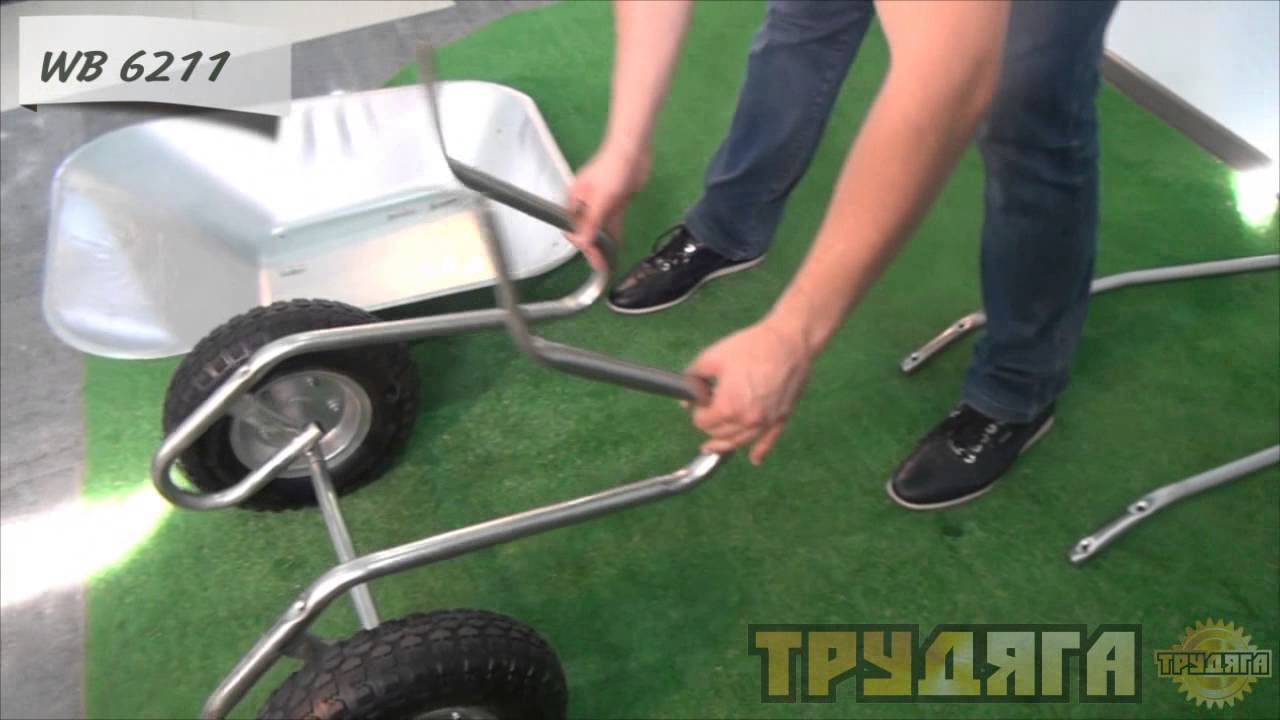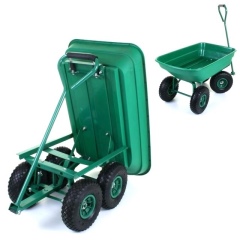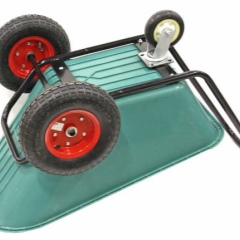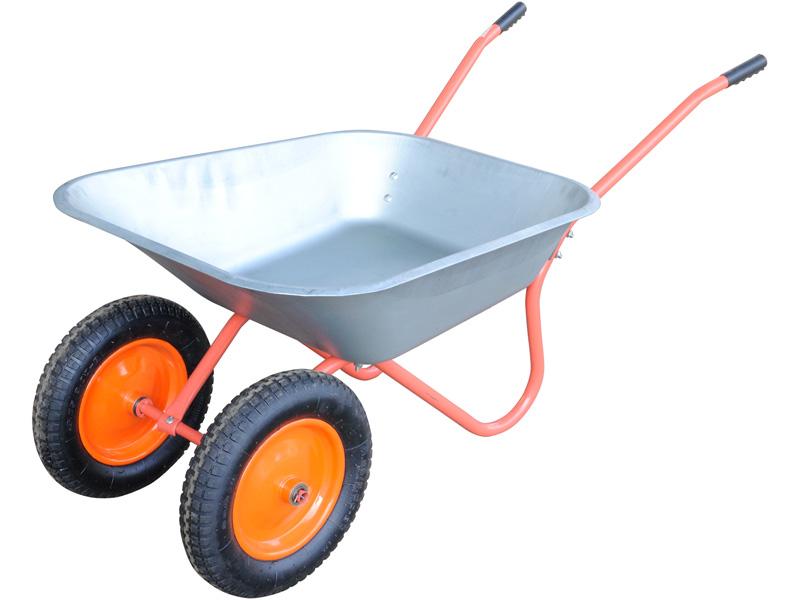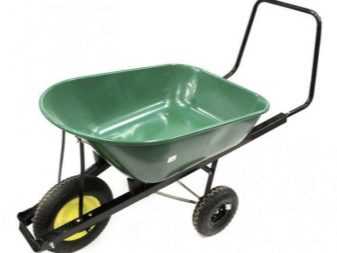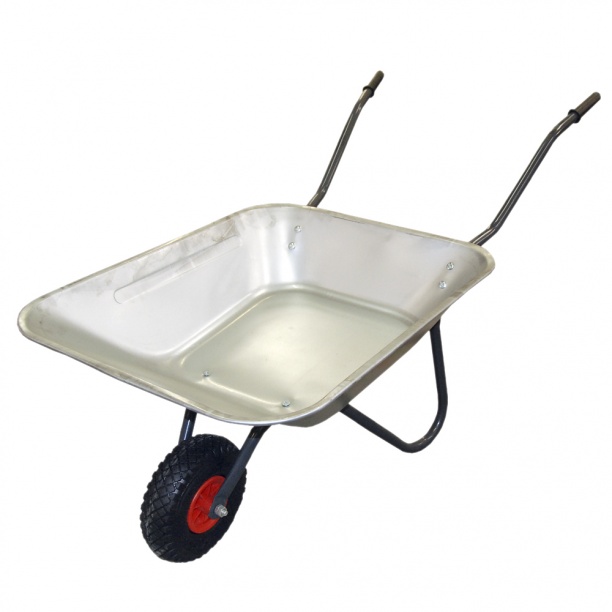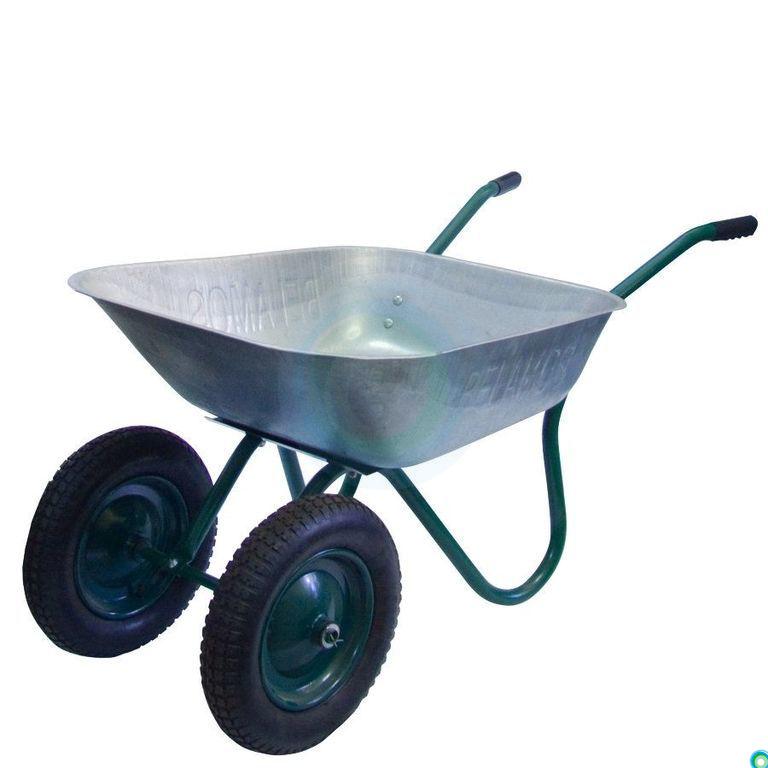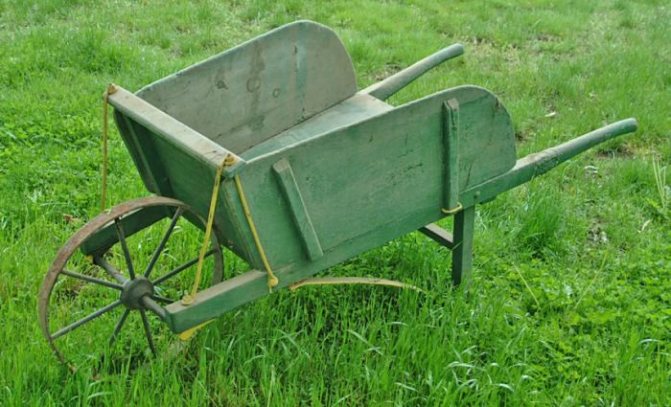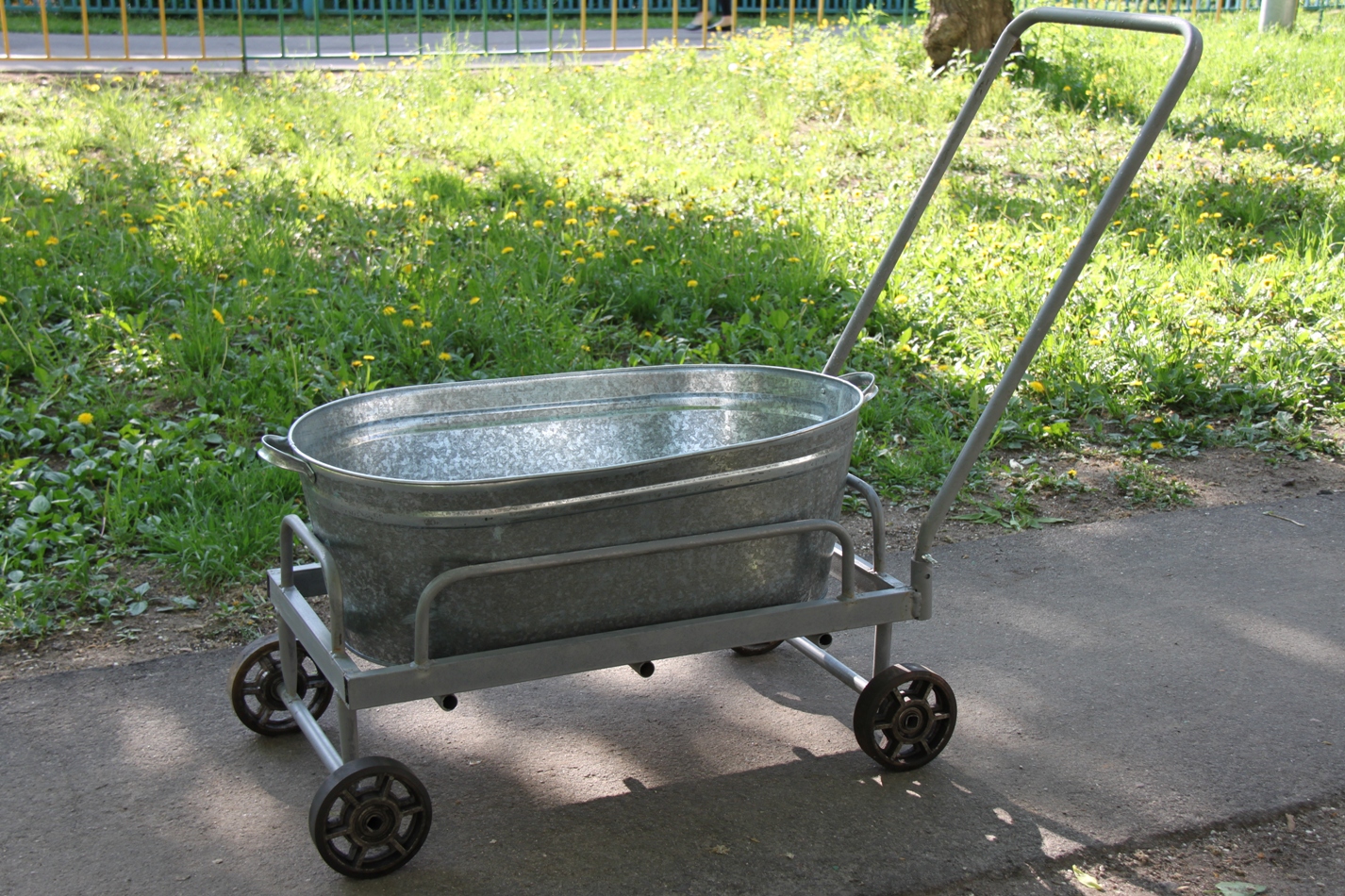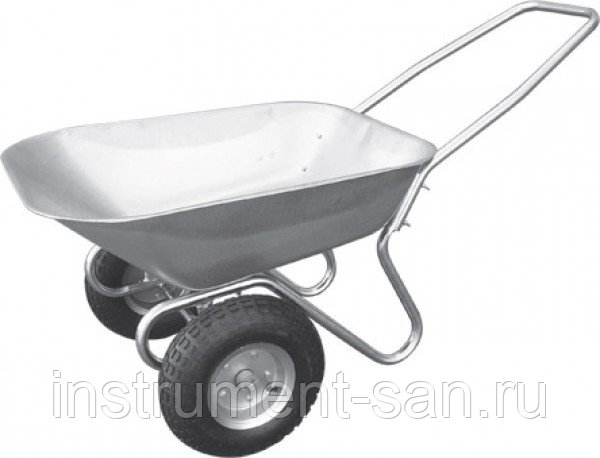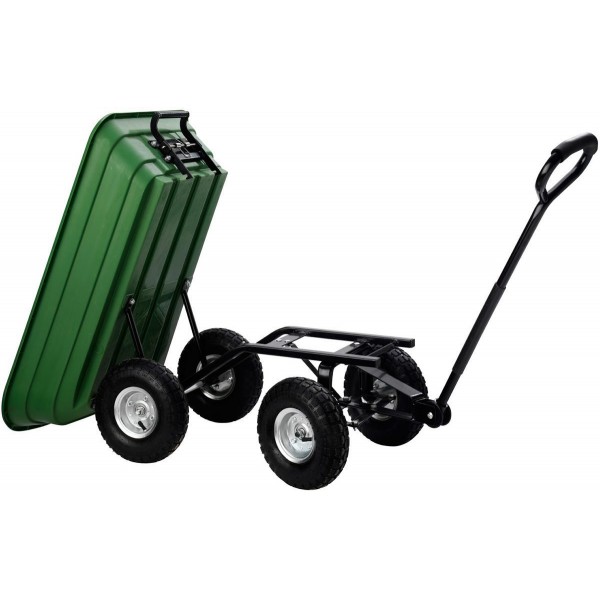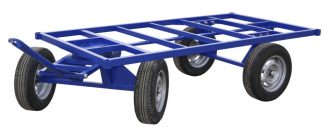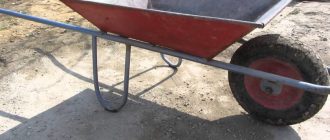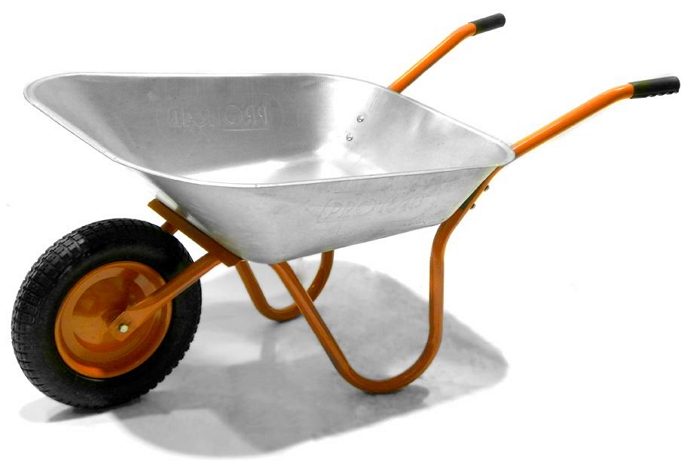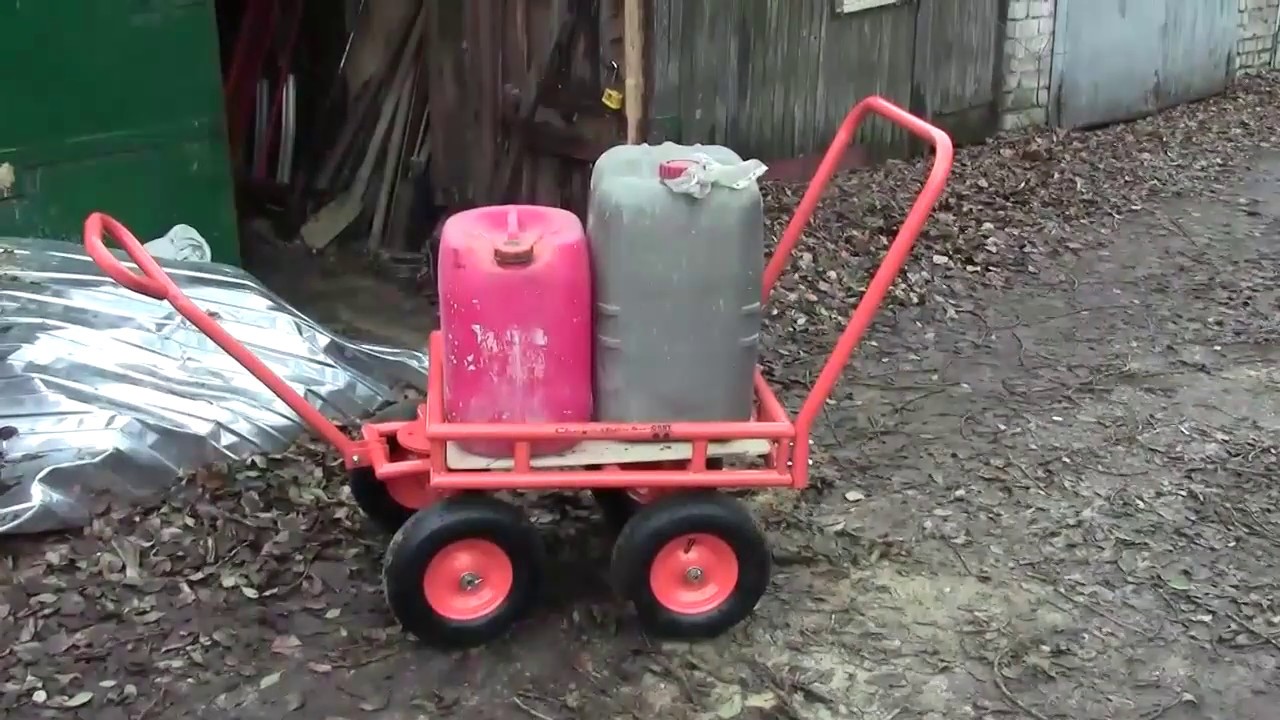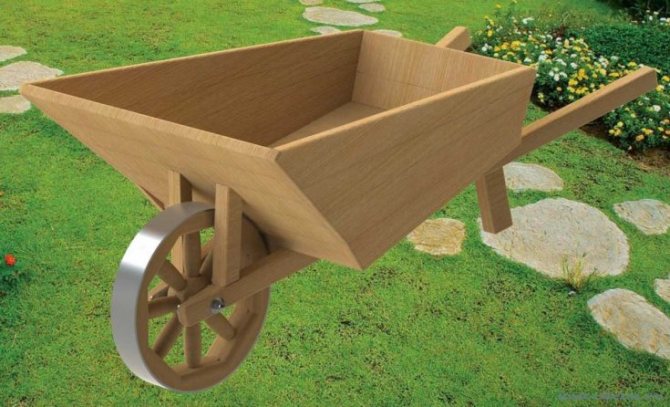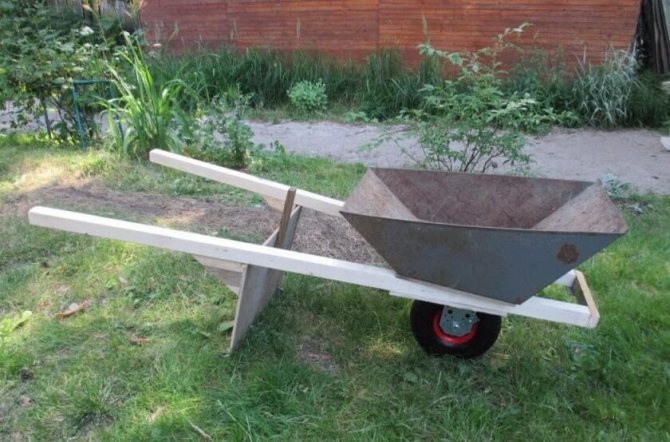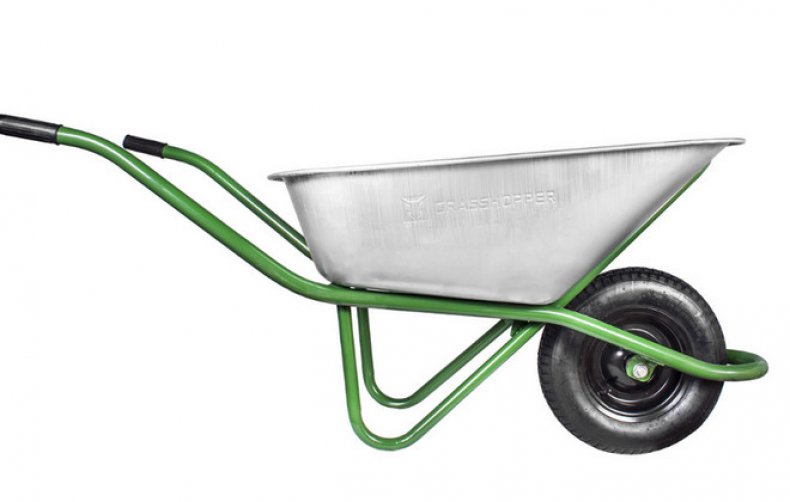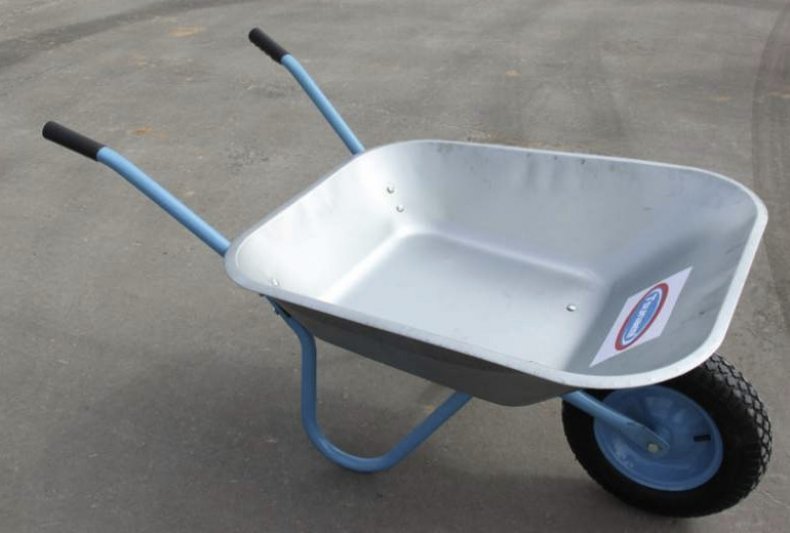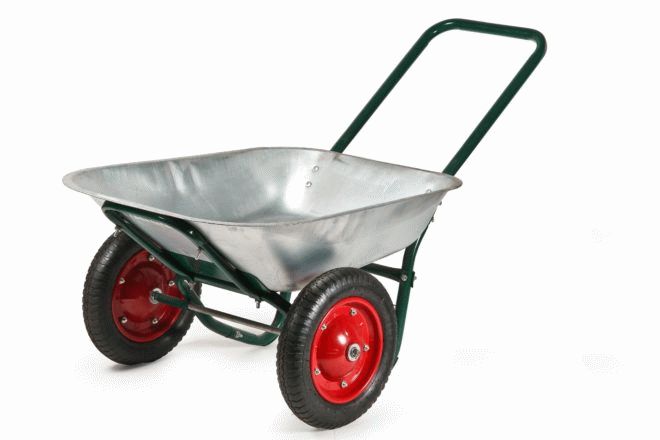Unicycle
One-wheel garden wheelbarrows are considered the lightest and most inexpensive. They are not very stable, but allow easy emptying of the contents.
Belamos T309R

The wheelbarrow is distinguished by its versatility - it is useful both in construction and in gardening work. The robust galvanized body handles the transport of cargo, sand, bricks, debris and liquids. The maximum load reaches 150 kilograms. The wheel is equipped with a bearing, which gives the structure stability on uneven surfaces. The weight of the structure is 12 kilograms.
Advantages:
- corrosion resistance due to galvanized coating;
- double curved sides are provided for protection against cuts;
- ease of use - the wheelbarrow is easy to assemble and disassemble;
- rubber grips prevent palms from slipping.
Reviews:
| Yuri | Alexey |
| A solid car that is well worth the money. Serves me faithfully for more than two years for carrying land, fertilizers and various tools. The only weak point is the bearing. A couple of months after the purchase, I replaced the wheel with a more reliable one. | A very simple car, which I assembled in just a few minutes without any problems. I bought it to work in the garden, sometimes I also used it to transport rubble. The wheel is wide, it goes well on the ground. |
Gigant WBG90
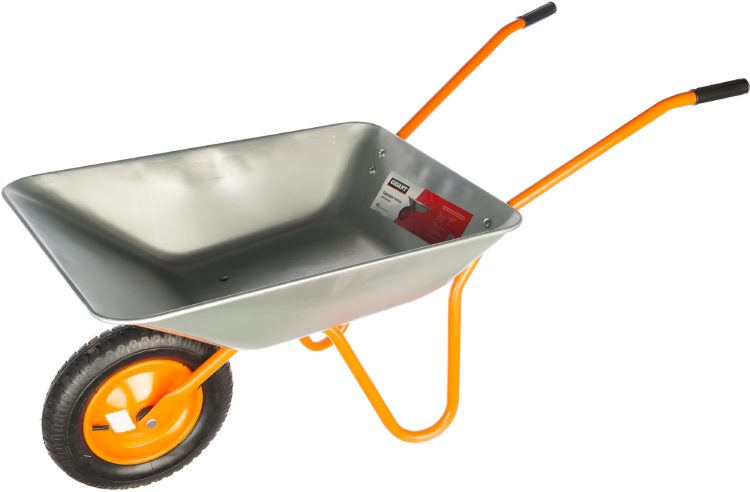
The wheelbarrow is used on personal plots for work in the garden and vegetable garden. Suitable for transporting solid and bulk material weighing up to 90 kilograms. The sturdy frame does not allow the structure to fail under any operating conditions. Galvanized surface prevents material deterioration. The 36 cm wheel provides maneuverability on uneven ground. The weight of the wheelbarrow does not exceed 7.5 kilograms.
Advantages:
- protection of materials from destruction thanks to the painted frame;
- resistance to loading and unloading due to double stop;
- roomy and deep trough for transporting any materials;
- the wheels are equipped with bearings for ease of movement.
Reviews:
| Vadim | Oleg |
| Lightweight wheelbarrow with a securely welded frame. It weighs almost nothing, so even the wife can easily handle it in the garden. The metal is thick, and the trough capacity is enough for the eyes. | The wheelbarrow copes with its direct goals, but has one big drawback - misalignment. One wheel looks to the right. Because of this, it seems that the structure is about to collapse on its side. |
Parameters important for a construction wheelbarrow
The first thing that professional builders pay attention to when choosing a wheelbarrow:
-body;
-frame;
-wheel or wheels;
-pens.
Requirements for the body when choosing a construction wheelbarrow
If the body is made correctly, then it will facilitate your work, reducing the strain on your hands. It should look like this:
- trapezoidal shape;
-the front part is angled. This contributes to an even distribution of the load. Large - falls on the wheel, and on the hands on average 20%;
- the bottom is flat, which allows you to load the wheelbarrow to the maximum;
-If you are going to transport a heavy load in the form of bricks, stones or blocks, then you need a reinforced construction wheelbarrow. Stiffeners must be present in its design, otherwise the body will quickly deform;
-in the case when a wheelbarrow is needed to move sand, cement, gravel or other bulk material, then a body without ribs and with rounded corners is more convenient;
-Manufacturers, taking care of the user, roll up the sides to prevent injury from sharp edges;
- the thickness of the metal plays an important role. Suddenly it turns out to be less than about 8 mm, then it is better not to buy such a wheelbarrow;
-Pay attention to the dimensions. The wheelbarrow must go through the wicket and doors; -Check whether it will be convenient to hold the wheelbarrow when unloading;
-Check whether it will be convenient to hold the wheelbarrow when unloading;
- the body must be tilted towards overturning;
-Check also if there are any backlashes. Do it like this: tip the wheelbarrow on its side and push on it. If the frame flexes a lot, it means that there are backlashes and there is no need to buy this model.
Frame construction
The frame is the backbone of the wheelbarrow, so it must be reliable. When purchasing, check if it meets the following requirements:
- there should be no welds on the frame. If they are, and even of low quality, i.e. uneven, intermittent, then this product is unsuitable for use in a construction site. The correct frame is made from a whole pipe, without any seams. If there are seams, then this is not a construction wheelbarrow, but a light garden cart;
-the correct frame goes around the entire perimeter of the body, serves as a support at the bottom, in front and supports the rear wall.
Comfortable handles
See that the handles are:
1.Long.
2.Spaced so that you can easily fit between them.
3. Made of non-slippery material or with attachments made of plastic, rubber.
Wheels
Wheelbarrow wheels are:
- cast;
- inflatable;
-diameter from 350 to 450 mm;
- sometimes with a bearing that makes it easier to move.
For particularly heavy work, a construction wheelbarrow with a cast wheel is more suitable. The product can be equipped with one or two wheels:
- two-wheeled cars are more stable. You can load a lot on them. It's easy to work with them;
- one-wheeled construction wheelbarrow provides better maneuverability, but creates a greater load on the hands. The cost differs from the 2-wheel drive by half, or even 3 times.
All the stated requirements are met by products from well-known manufacturers such as: Russian companies BELAMOS, VINCO, ZUBR; French company HAEMMERLIN.
Peculiarities
The wheelbarrow was invented a long time ago, perhaps when the wheel began to be used. Animal carts appeared much later. The simplest design is one-wheeled. The axis is fixed at the point of convergence of the poles, the continuation of which serves as the conveyor handles. On these poles (bars) a cargo platform is installed, which eventually became a box or box. The design of the wheelbarrow has undergone a number of major changes in accordance with the scope of its application. Lighter garden wheelbarrows and reinforced construction ones appeared.
The scope of their application is very wide:
- delivery of materials directly to the place of their use, which is often impossible to do on a truck due to limited space;
- removal of construction waste directly from the facility;
- moving consumables on site.
Of course, all this can be done manually. But it will be very difficult to transfer several bags of cement and mortar weighing from 25 to 50 kg. It is also possible to move garbage in buckets, but the time and effort spent on the same work with a wheelbarrow can be reduced several times.
A modern construction wheelbarrow is a product that combines a whole range of technical solutions: a frame made of a steel pipe with a diameter of up to 4 cm, 1 or 2 wheels with pneumatic tires, often of a rather large diameter. At the same time, the wheels are mounted on the axles using bearings, which makes the movement of the vehicle quite easy. For the convenience of loading, stands are arranged from a bent pipe, often they are a continuation of the reinforced frame of the conveyor. The handles are rubber or plastic coated to prevent slipping. The center of gravity of a modern construction wheelbarrow is distributed so that during transportation the main load falls on its wheels.
The cargo container is made of steel or aluminum, with the help of stamping it is given a shape that is convenient for unloading without assistance. It is enough to tilt such a wheelbarrow, and the bulk cargo (for example, sand) rolls off itself under the influence of its own weight, which significantly reduces labor costs. The carrying capacity of construction one-wheeled wheelbarrows can reach 100 kg with a volume of about 50 liters. For two-wheeled models, these figures can be tripled. The most technologically advanced are modern reinforced construction vehicles with a motor. The cost of this equipment is quite high and is hardly justified for a private backyard, but for large construction companies or in a warehouse, such transport equipment can be cost-effective.
How to choose?
When choosing a construction wheelbarrow, you need to consider a number of criteria.
First of all, the nature of the use of equipment: for what goods. This will usually be sand. For bulk cargo, an aluminum or galvanized trough is very convenient, and for the transportation of bulky rectangular materials it will present significant difficulties. Bricks or cinder blocks are mandatory construction waste. The most convenient form for their transportation is a trapezoid. The bottom of such a trough is flat, the back and side walls are at right angles to it and to each other. And the front wall is sloped so that when the wheelbarrow rolls over, the load should easily roll under its own weight.
It is necessary to take into account the peculiarities of who will use the wheelbarrow
Heavy two-wheeled reinforced wheelbarrow may be beyond the reach of older people or adolescents.
It is equally important to consider how you can use the wheelbarrow after construction is completed. If it is in fairly good condition, it can serve in the household for many years to come as a universal transporter, including as garden tools.
Buying a reinforced model when building a private house or garage is hardly justified. It will be problematic to use such a unit in the future. If a wheelbarrow is purchased for the construction business and will be intensively operated only at a construction site, it is impractical to purchase a lightweight version: the inevitable regular overloads will lead to its rapid breakdown and the need to re-purchase.
Reliability is an equally important indicator. Before buying, it is very useful to inspect the welded seams: the quality of their processing can say a lot, and even with a cursory examination, you will get an idea of the professionalism and responsibility of the manufacturer.
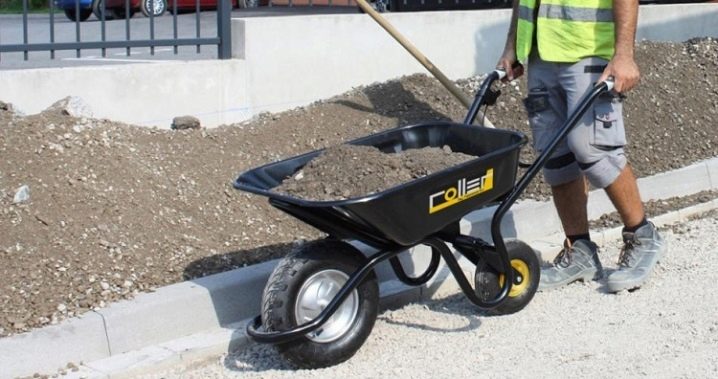
For information on how to make a construction wheelbarrow with your own hands, see the next video.
Carrying capacity and capacity
These are the most important characteristics to consider when choosing a garden cart. Most of them have a carrying capacity range from 70 to 130 kg and are designed to move not very heavy loads... To be able to carry large weights, you will have to buy a garden trolley with an increased capacity or a construction trolley. Its carrying capacity can reach 250 kg, but it is quite heavy to operate. Correlate the required value of this characteristic with your needs.
Capacity is the amount of volume of liquid or bulk cargo that can fit in the body. Modern garden handcarts have a capacity of 80–150 liters. The greater the value of these two characteristics, the more expensive the trolley will cost.
Remember that the right trolley will serve you faithfully for decades.
Table 2. Best Wheelbarrow for Different Sizes
How to choose
Let's find out the main points that need to be borne in mind when purchasing a two-wheeled garden wheelbarrow.
Carrying capacity
This criterion is one of the most important. Manufacturers indicate the lifting capacity in kilograms. As a rule, this figure ranges from 60 to 150 kg. What is higher is already products intended more for construction work.It should be borne in mind that the higher the carrying capacity, the less maneuverable and easy to operate the wheelbarrow becomes, and the lower this indicator, the less profitable the purchase in principle becomes.
The own weight of the product should not be more than 35 kg, otherwise it will be very difficult to manage it. Ideally 15-25 kg.
Basically, the trolley is selected for the needs of the proposed landscaping of the courtyard of a private house.
Capacity
This indicator is indicated in liters. Typically, garden wheelbarrows have a capacity of 60 to 120 liters - and this is enough to achieve the desired goals. The construction models have a large capacity - from 120 to 140 liters. Read about the telescopic pruner for pruning tall trees in this article.
The video shows how to choose a two-wheeled garden wheelbarrow:
Wheels
Large wide wheels of the wheelbarrow are a guarantee of the product's patency. The optimum diameter of the disc is 35-45 cm. Note that wheelbarrows with pneumatic wheels with an inflatable inner chamber have gained particular popularity.
The larger the wheels, the higher the permeability
Such wheels give the wheelbarrow increased cross-country ability: the device will be able to drive even on viscous, loose, uneven ground.
Pens
It is more convenient to use a wheelbarrow equipped with two parallel handles. Such a product is easy to hold and maneuver.
Make sure when shopping that the grip of the handrails has a curvature: this condition will ensure ease of use and prevent the arms from twisting. This link will tell you about a self-propelled, gasoline mower.
Frame
It is important that the frame design is reliable - this is the key to the stability and strength of the entire product. The most reliable frames are now considered to be made of solid steel pipes.
However, products with bent-welded frames are also commercially available - and are quite suitable for garden work.
Make sure the frame fits securely and tightly to the body on all sides. Thus, the body will be securely supported.
Body
The shape of this part can be of two types:
- trapezoidal;
- square.
The first form makes it easy to unload the device, and the second one - qualitatively and accurately place the load inside. For gardening work, the best choice is a product with a sloping body at the front and a flat bottom.
Material
It is best to purchase a product made of high quality galvanized steel. The top coat will prevent rust and moisture deterioration. It is recommended to purchase a unit with a steel wall thickness of 0.8 to 1.5 mm - such a product will be of the highest quality and most reliable. Read about the cordless shrub shears here.
Galvanized wheelbarrows are more practical
On sale you can find products with bodies made of wood or plastic. The first option is environmentally friendly, but more careful care will be required, the second option is easier than the steel one, but less stable and reliable. Plastic devices are not used to move heavy loads, but are optimal for transporting fallen leaves, dry soil, light debris.
You may also be interested in information about what kind of project of landscape design of the site exists.

